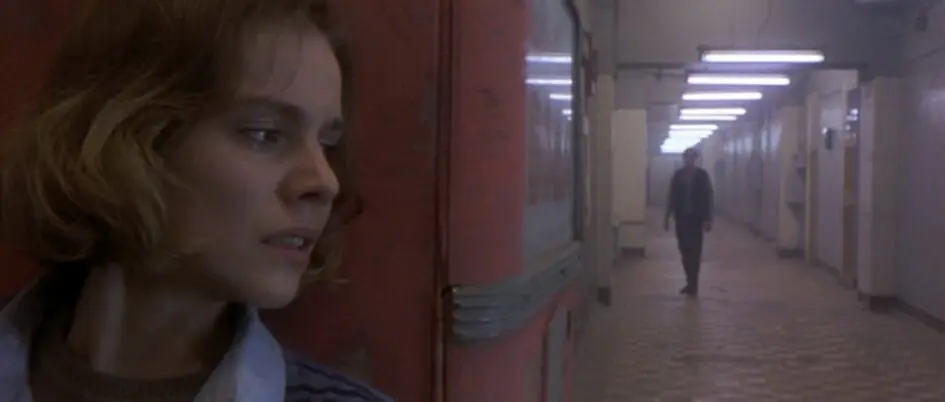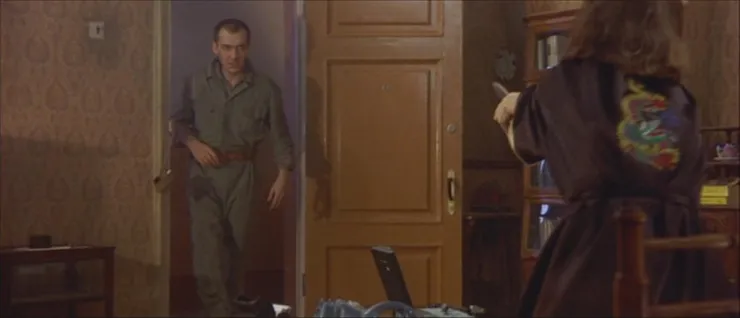In the realm of horror cinema, 1995 was a remarkable year. Se7en, starring Morgan Freeman and Brad Pitt, captivated audiences with its dark tone and macabre subject matter. Director Roger Donaldson’s Species followed a team of scientists attempting to thwart a genetically engineered alien-human hybrid. And then there’s The Prophecy, a personal favorite, which envisioned a world where angels rebel against God. Many other horror films captured the imagination of the public in 1995, each offering a distinctive perspective on the genre, spanning psychological thrillers to supernatural tales, enriching the diversity of horror cinema during that era.
However, one often overlooked gem from that year is Mute Witness.
Written and directed by Anthony Waller, the film follows Billy (Marina Zudina), a mute makeup artist, as she works on a low-budget horror movie in Moscow. One fateful night, after a day of filming, Billy finds herself trapped inside the studio. Desperate, she calls her sister, Karen (Fay Ripley), and her boyfriend, Andy (Evan Richards), for help, only to discover that another production has begun filming on one of the sets.
Initially mistaken for a porn shoot, the situation quickly escalates into a horrifying turn of events when the female performer is brutally murdered on camera.
As Billy becomes the target of the killers, Arkadi (Igor Volkov) and Lyosha (Sergei Karlenkov), a frantic manhunt ensues. Seeking protection, Billy and Karen enlist the help of Det. Aleksander Larsen (Oleg Yankovskiy). However, they soon realize the film’s ties extend into the Russian mafia and its mysterious financier, known only as The Reaper (Alec Guinness).
Mute Witness marked the final cinematic appearance of Alec Guinness, renowned to many fans as Obi-Wan Kenobi from the original Star Wars trilogy, before his passing in 2000. Waller revealed that Guinness’ work was filmed in 1985, a decade before the movie’s eventual release. Alec graciously agreed to film one scene without accepting any payment for his role. To maximize the use of his footage, Waller would reverse the footage taken of Sir Alec during the rest of the filming process.
Unlike some of the aforementioned horror films that leaned toward true crime or supernatural elements, Mute Witness took a different direction. Much of the film evokes the atmosphere of an ’80s slasher film. Graphic kill scenes are abundant, with copious amounts of blood filling the screen with visceral gore. The accompanying music during these scenes bears resemblance to iconic horror movie scores like those from Psycho and Friday the 13th. The camera frequently zooms into the victims’ eyes, synchronizing with the beats of the music.
Although somewhat comical, these moments accentuate the campy style embraced by Mute Witness. Knowing that the filming began in the ’80s, it is understandable that Waller chose to go this route with his movie.
Billy emerges as one of the most compelling characters in the horror genre, evoking genuine sympathy from the audience. She isn’t portrayed as irrational or unintelligent; rather, her inability to speak amplifies the tension in the film to an almost surreal extent. For instance, in an early scene, Billy is pursued out of the studio by Arkadi and Lyosha. After a fall, Lyosha nearly delivers a fatal blow, but Karen arrives just in time. Playing the role of a concerned bystander, Lyosha tries to persuade Karen to seek help, intending to finish the job once she is gone.
Billy’s inability to effectively communicate with Karen nearly leads to her leaving, thwarted only by an uneasy feeling by Karen. Despite Lyosha’s convincing act, every moment feels like Billy is on the brink of death. Later, Billy is unable to speak to the 911 operator she calls while being attacked. Intense interactions like these immerse the audience in Billy’s perspective, evoking a palpable sense of helplessness. This feeling of vulnerability serves as the cornerstone of Mute Witness, amplifying its impact on the viewer.
Mute Witness stands as a hidden treasure within the realm of horror, deserving far more recognition than it receives. I award it a solid four out of five stars. Nearly three decades since its release, Mute Witness merits inclusion alongside other standout films from the same era. It’s evident that director Anthony Waller poured his heart and soul into crafting this cinematic experience. The film seamlessly blends elements of ’80s slasher horror with gripping true-crime drama, resulting in a captivating viewing experience.
With its recent availability on Shudder, I hope that Mute Witness garners the attention it truly deserves from a wider audience.

